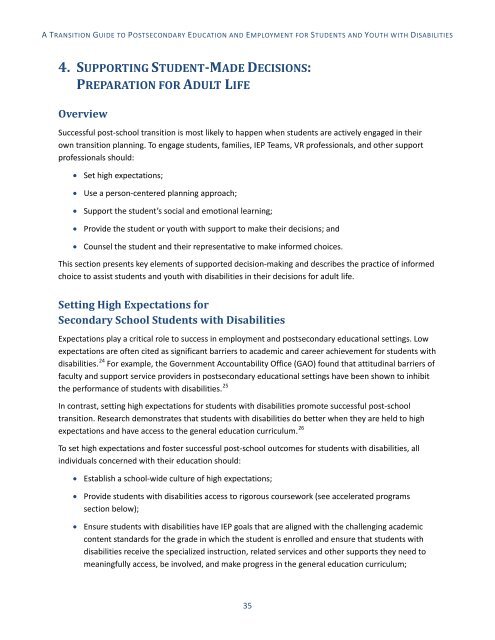TRANSITION GUIDE
2j9tM4H
2j9tM4H
You also want an ePaper? Increase the reach of your titles
YUMPU automatically turns print PDFs into web optimized ePapers that Google loves.
A <strong>TRANSITION</strong> <strong>GUIDE</strong> TO POSTSECONDARY EDUCATION AND EMPLOYMENT FOR STUDENTS AND YOUTH WITH DISABILITIES<br />
4. SUPPORTING STUDENT-MADE DECISIONS:<br />
PREPARATION FOR ADULT LIFE<br />
Overview<br />
Successful post-school transition is most likely to happen when students are actively engaged in their<br />
own transition planning. To engage students, families, IEP Teams, VR professionals, and other support<br />
professionals should:<br />
• Set high expectations;<br />
• Use a person-centered planning approach;<br />
• Support the student’s social and emotional learning;<br />
• Provide the student or youth with support to make their decisions; and<br />
• Counsel the student and their representative to make informed choices.<br />
This section presents key elements of supported decision-making and describes the practice of informed<br />
choice to assist students and youth with disabilities in their decisions for adult life.<br />
Setting High Expectations for<br />
Secondary School Students with Disabilities<br />
Expectations play a critical role to success in employment and postsecondary educational settings. Low<br />
expectations are often cited as significant barriers to academic and career achievement for students with<br />
disabilities. 24 For example, the Government Accountability Office (GAO) found that attitudinal barriers of<br />
faculty and support service providers in postsecondary educational settings have been shown to inhibit<br />
the performance of students with disabilities. 25<br />
In contrast, setting high expectations for students with disabilities promote successful post-school<br />
transition. Research demonstrates that students with disabilities do better when they are held to high<br />
expectations and have access to the general education curriculum. 26<br />
To set high expectations and foster successful post-school outcomes for students with disabilities, all<br />
individuals concerned with their education should:<br />
• Establish a school-wide culture of high expectations;<br />
• Provide students with disabilities access to rigorous coursework (see accelerated programs<br />
section below);<br />
• Ensure students with disabilities have IEP goals that are aligned with the challenging academic<br />
content standards for the grade in which the student is enrolled and ensure that students with<br />
disabilities receive the specialized instruction, related services and other supports they need to<br />
meaningfully access, be involved, and make progress in the general education curriculum;<br />
35


